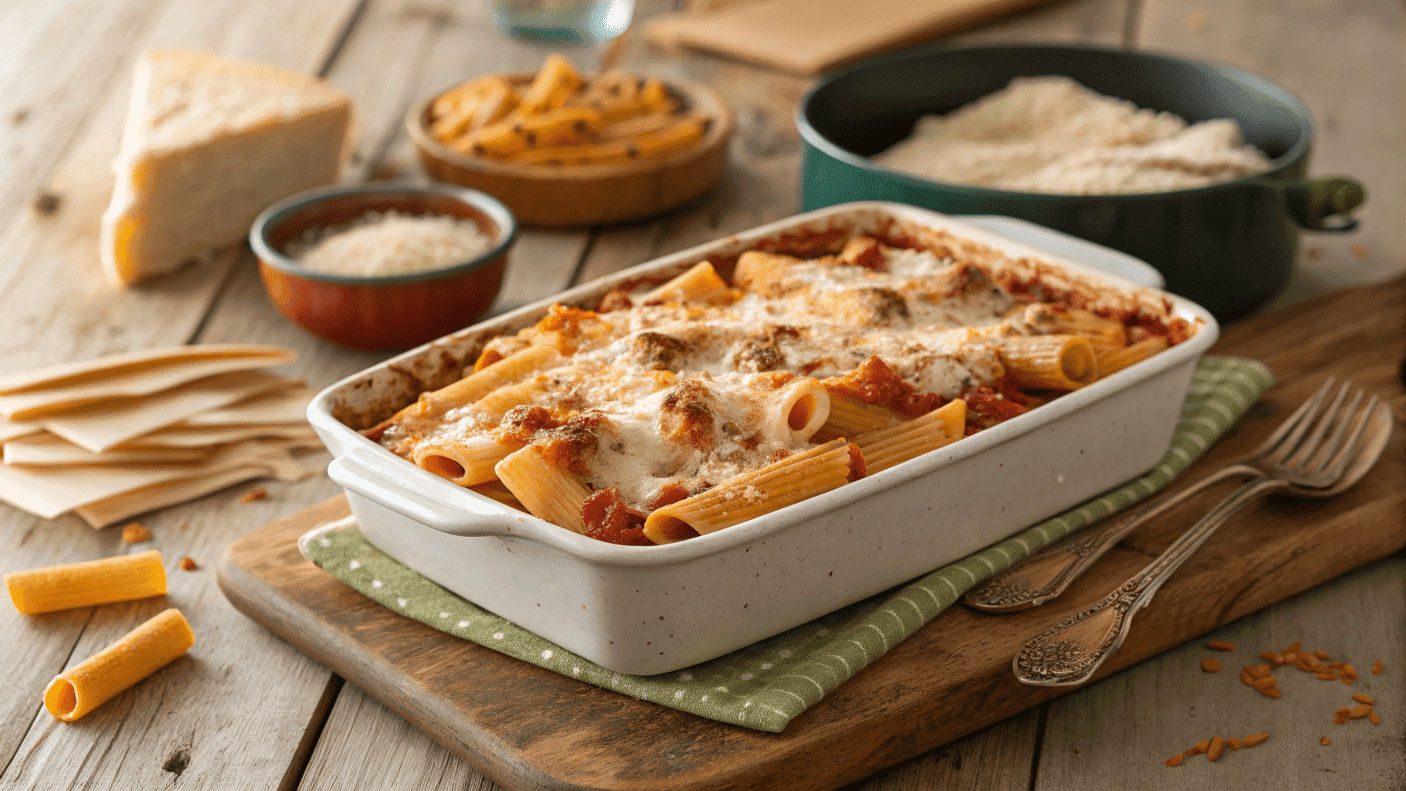Have you ever wondered what is another name for ziti pasta? It’s a common question for pasta lovers who adore its versatile, tube-like shape. Whether you’re preparing a comforting baked dish or a fresh pasta salad, knowing the alternatives can save the day. Ziti’s simple yet elegant style has made it a kitchen favorite, and finding substitutes that work just as well opens up endless culinary possibilities.
Ziti pasta isn’t just about tradition—it’s about creating meals that bring everyone to the table. Its smooth texture and hollow center make it perfect for holding rich sauces or delicate seasonings. And here’s the fun part: there are so many similar pastas to experiment with, each offering its own charm. Ready to dive into the world of ziti and its flavorful cousins? Let’s explore everything you need to know to make your next pasta dish unforgettable!
Table of Contents
Understanding Ziti Pasta: A Versatile Classic
The Unique Texture and Shape of Ziti Pasta
Ziti pasta is famous for its smooth, tube-like shape that is slightly longer than other short pastas. Its hollow center is perfect for holding sauces, whether they’re creamy, tomato-based, or loaded with savory spices. This shape gives every bite a balanced blend of sauce and pasta, making it incredibly satisfying.
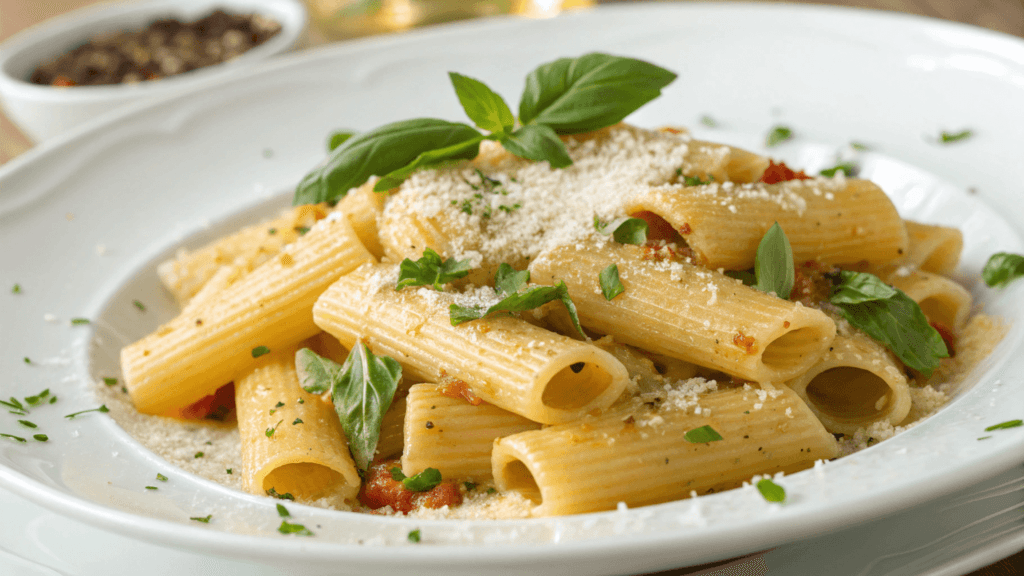
Unlike ridged pasta like penne, ziti has a sleek and polished surface. This texture works well in dishes where a smooth finish is ideal, such as baked recipes or light, delicate sauces. The tube shape also makes it versatile—it cooks evenly and holds its structure, even in baked dishes.
If you’re curious what is another name for ziti pasta, you’ll often find it called “maccheroni” in traditional Italian cuisine. Both share a similar structure, but ziti tends to be longer and straighter. Its name comes from the Italian word for “bride,” as ziti was traditionally served at weddings.
Characteristics of Ziti Pasta:
Feature | Description | Why It Matters |
|---|---|---|
| Shape | Smooth, long, and tubular | Perfect for trapping sauces |
| Texture | Polished and sleek | Ideal for baked dishes or light sauces |
| Structure | Maintains shape when cooked | Works well in casseroles and baked ziti dishes |
| Versatility | Complements a variety of sauces and dishes | Adds flexibility to recipes |
In this guide, we’ll explore alternative names, its characteristics, and how to use it in classic and creative recipes. For a deeper dive into similar pasta shapes, check out this Gigli Pasta Guide.
Traditional Dishes That Highlight Ziti’s Versatility
Ziti pasta shines in classic recipes that bring families together. Its most famous role is in baked ziti, a comforting dish layered with rich tomato sauce, gooey cheese, and sometimes a touch of cream. This dish is a favorite at gatherings because it’s hearty, flavorful, and easy to prepare.
In addition to baked ziti, it’s often used in lighter pasta salads. These salads combine fresh vegetables, ziti, and a tangy dressing for a refreshing dish. Ziti also works beautifully in soups, where its tube-like structure adds texture to broths.
If you’re wondering what is another name for ziti pasta, consider maccheroni or “bride’s pasta.” This name reflects its importance in celebratory meals. Whether baked, tossed, or served in soup, ziti adapts to nearly any flavor profile.
| Dish | How It’s Used | Why Ziti Works Well |
|---|---|---|
| Baked Ziti | Layered with sauce and cheese in the oven | Holds up under high heat |
| Pasta Salad | Tossed with fresh veggies and light dressing | Maintains structure and absorbs dressing |
| Soups | Added to broths for texture and heartiness | Fits well in soups without becoming mushy |
Ziti pasta’s versatility and smooth texture make it a staple in kitchens everywhere. Whether baked or tossed, it’s always a star! If you’re comparing it to other pastas, learn about the subtle differences in our article, Is Baked Ziti the Same as Mostaccioli?.
Alternative Names for Ziti Pasta in Italian and Global Cuisine
Regional Italian Names and Their Origins
In Italy, pasta shapes often have unique names depending on the region. Ziti, for example, is sometimes referred to as “zite” in southern Italy, particularly in Naples. This name is derived from the Italian word for “brides,” as ziti is traditionally served at wedding celebrations. It symbolizes joy, togetherness, and the beginning of a new chapter.
In other regions, you might hear ziti called “maccheroni,” a term that broadly refers to tubular pasta shapes. This name is commonly used in areas like Sicily and Calabria, where pasta is paired with rich tomato sauces and fresh herbs. Each name reflects regional traditions, making ziti a deeply rooted part of Italian culinary culture.
If you’re exploring Italian recipes, knowing these names can help you identify ziti pasta, even if the packaging doesn’t say “ziti.” It’s like learning a bit of Italian history while you cook!
| Region | Name | Context |
|---|---|---|
| Naples | Zite | Traditionally served at weddings |
| Sicily | Maccheroni | A general term for tubular pasta shapes |
| Southern Italy | Zitoni | Refers to larger versions of ziti, often baked |
International Variations: How Ziti is Known Around the World
Outside of Italy, ziti has inspired many names and adaptations. In the United States, it’s often just called “baked ziti” due to its popularity in casseroles. In some countries, ziti might be labeled as “pasta tubes” or grouped under the category of macaroni.
In Greece, a similar pasta called “pastitsio” is used in layered dishes, much like baked ziti. In France, it’s occasionally referred to as “tubetti,” emphasizing its small, hollow structure. Despite the different names, these variations all share ziti’s ability to hold sauces and stay firm during cooking.
Key International Variations of Ziti:
- United States: Often labeled as “baked ziti,” emphasizing its use in casseroles.
- Greece: Known as “pastitsio” and used in creamy, layered dishes.
- France: Referred to as “tubetti,” highlighting its tubular shape.
| Country | Name/Variation | Common Use |
|---|---|---|
| United States | Baked Ziti | Used in casseroles with cheese and tomato sauce |
| Greece | Pastitsio | Layered dishes with creamy sauces |
| France | Tubetti | Similar to ziti, used in soups and casseroles |
Ziti’s ability to adapt across cultures is a testament to its versatility. No matter what it’s called, it always delivers delicious results!
Ziti Pasta vs. Similar Pasta Shapes: Key Comparisons
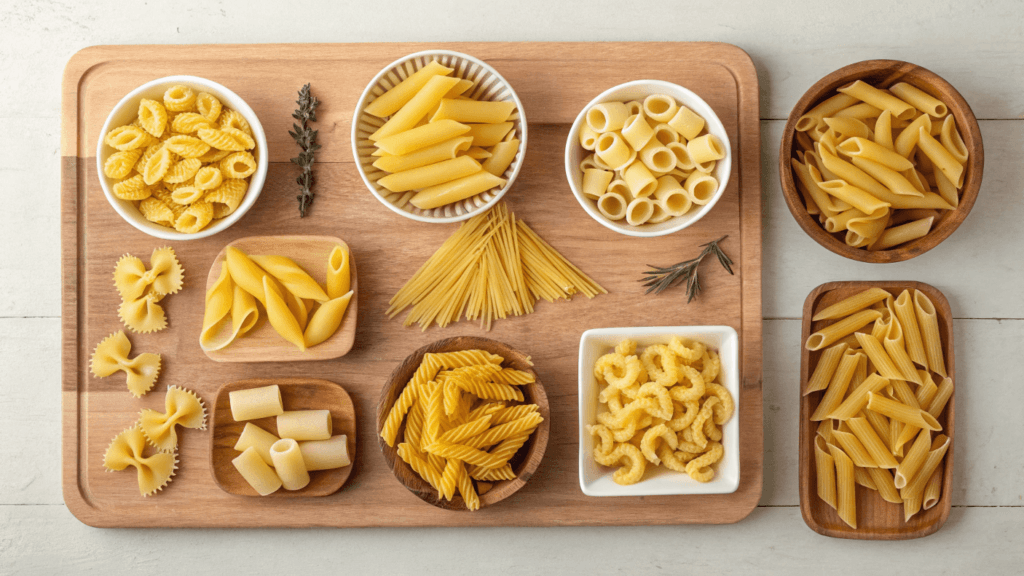
Comparing Ziti with Penne, Rigatoni, and Bucatini
Ziti is unique, but it shares similarities with other pasta shapes like penne, rigatoni, and bucatini. Penne, for example, is slightly shorter and has diagonal ends, while ziti features straight cuts. Penne’s ridges help sauces cling better, making it ideal for chunky and hearty sauces. In contrast, ziti’s smooth surface works wonderfully with creamy or lighter sauces.
Rigatoni is larger and ridged, giving it a robust structure that holds up in baked dishes and meaty sauces. It’s perfect for bold flavors and hearty meals. Meanwhile, bucatini stands out with its spaghetti-like shape and hollow center. It’s excellent for brothy dishes and oil-based sauces.
Understanding these differences helps you decide which pasta to use based on the recipe. While ziti excels in baked dishes, penne and rigatoni are better for thicker sauces, and bucatini adds fun texture to soups and lighter recipes.
| Pasta Type | Key Features | Best Use Cases |
|---|---|---|
| Ziti | Straight, smooth tubes | Baked dishes, creamy sauces, and pasta salads |
| Penne | Ridged, diagonal-cut tubes | Chunky sauces, casseroles, and stovetop dishes |
| Rigatoni | Large, ridged tubes | Meaty sauces, baked recipes, and hearty casseroles |
| Bucatini | Hollow, spaghetti-like | Broths, oil-based sauces, and soups |
Best Recipes for Ziti vs. Its Closest Alternatives
When it comes to recipes, ziti pasta shines in baked dishes like the classic baked ziti. Its smooth texture pairs perfectly with rich tomato sauces and gooey cheese. Penne, however, works best in stovetop recipes where ridges hold chunky ingredients like diced vegetables or meat. Rigatoni is your go-to for heavy, meat-based sauces or baked casseroles that require sturdy pasta.
Bucatini offers a fun twist for lighter recipes. Its hollow center makes it great for soaking up flavorful oils or broths. While ziti is best for layered casseroles, these alternatives add their own charm to a variety of dishes.
Key Recipe Tips:
- Use ziti for baked pasta dishes with creamy or cheesy layers.
- Opt for penne in quick stovetop recipes with chunky sauces.
- Choose rigatoni for rich, hearty casseroles or thick tomato sauces.
- Try bucatini for light, broth-based soups or simple garlic oil dishes.
| Pasta Type | Best Recipes | Why It Works |
|---|---|---|
| Ziti | Baked ziti, creamy casseroles | Holds sauce and stays firm in baked recipes |
| Penne | Stovetop pasta with chunky sauces | Ridges grip sauces perfectly |
| Rigatoni | Meaty casseroles, hearty stews | Sturdy and absorbs bold flavors |
| Bucatini | Light soups, oil-based pasta dishes | Hollow center traps delicate sauces |
Choosing the right pasta ensures your dish turns out perfectly every time. While ziti is versatile, each alternative brings its own unique benefits to the table! Explore a no-meat version of a classic baked dish with this Baked Ziti Recipe.
Perfect Cooking and Pairing Tips for Ziti Pasta
Achieving Ideal Texture: Cooking Tips for Ziti and Substitutes
Cooking ziti pasta to perfection is easier than you think! First, bring a large pot of water to a rolling boil. Use at least 4-6 quarts of water per pound of pasta to prevent sticking. Add a generous pinch of salt to enhance flavor—it should taste like the sea.
Once the water is ready, add the ziti and stir immediately to prevent clumping. Set a timer based on the package instructions but start testing the pasta a minute or two early. Al dente texture is key—firm but cooked through. Overcooking can cause the pasta to lose its shape, especially for baked dishes.
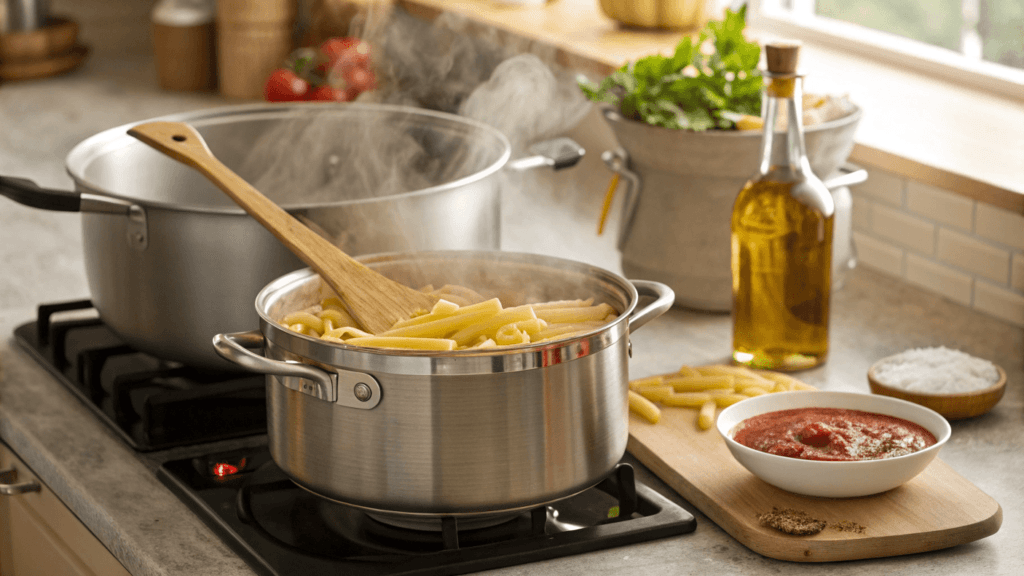
After draining, avoid rinsing the pasta unless you’re using it for a cold salad. The starch helps the sauce cling beautifully. These steps also work well for ziti substitutes like penne, rigatoni, or bucatini.
| Step | Tip | Why It’s Important |
|---|---|---|
| Boiling Water | Use 4-6 quarts per pound of pasta | Prevents pasta from sticking together |
| Salt the Water | Add 1-2 tablespoons | Enhances the natural flavor of the pasta |
| Cooking Time | Follow instructions, test early | Ensures al dente texture for better structure |
| Avoid Rinsing | Do not rinse pasta unless for cold dishes | Preserves starch to hold sauces |
Choosing the Best Sauces and Ingredients for Ziti Recipes
Ziti’s smooth surface pairs wonderfully with both rich and light sauces. Creamy Alfredo, hearty tomato, and zesty pesto all work beautifully. For baked ziti, marinara with layers of mozzarella and Parmesan creates a classic comfort dish. For a lighter option, toss ziti with olive oil, garlic, and sautéed vegetables.
Adding fresh herbs like basil or parsley enhances flavor and brings a fresh touch. Ziti also works well with protein-packed additions like grilled chicken or roasted vegetables. Substitutes like penne or rigatoni can follow similar pairings but consider their textures when choosing sauces.
Key Sauce Pairing Tips:
- Creamy Alfredo sauces are perfect for ziti’s smooth texture.
- Marinara pairs well for baked dishes and adds a classic flavor.
- Olive oil and garlic create a light, refreshing option for salads.
- Pesto works beautifully for cold or warm dishes, adding bold flavor.
| Pasta Type | Best Sauce | Why It Works |
|---|---|---|
| Ziti | Creamy Alfredo, Marinara | Clings to smooth surface, ideal for baked dishes |
| Penne | Chunky tomato, pesto | Ridges grip sauces perfectly |
| Rigatoni | Meaty ragu, hearty tomato | Larger size holds thick, bold sauces |
| Bucatini | Light olive oil, broth-based sauces | Hollow center traps delicate flavors |
By pairing ziti with the right sauces and cooking it to perfection, you’ll always create dishes that are flavorful and satisfying. Happy cooking!
Creative Ziti Pasta Recipe Ideas for Every Occasion
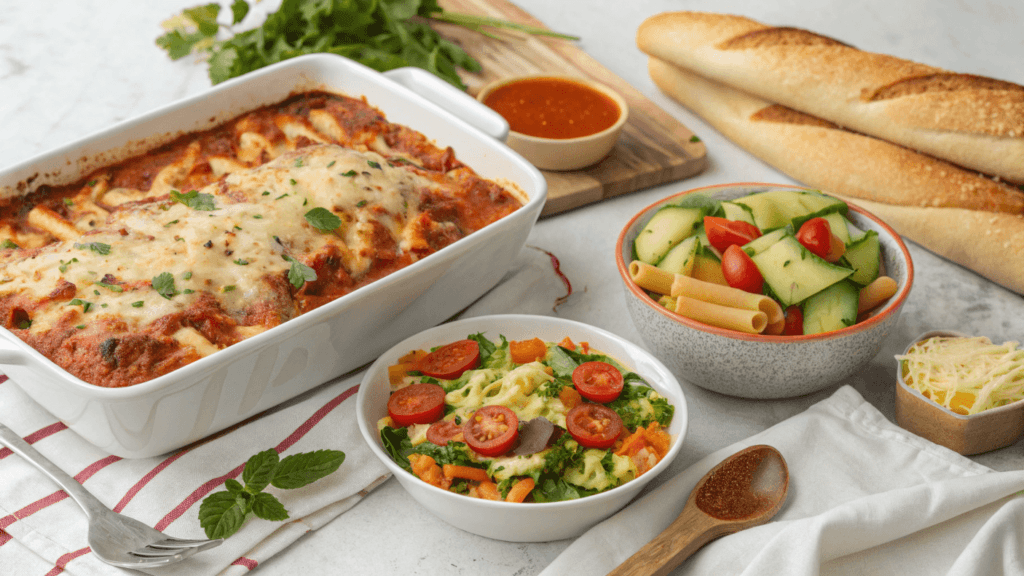
Baked Ziti Variations for Comfort Food Lovers
Baked ziti is the ultimate comfort food, but there are endless ways to make it your own! Start with the classic recipe: layer cooked ziti with marinara sauce, mozzarella, and Parmesan, then bake until bubbly and golden. For a heartier option, add sautéed vegetables like spinach or mushrooms. They blend beautifully with the cheese and sauce, adding extra flavor and nutrients.
If you’re feeling adventurous, swap marinara for a creamy Alfredo sauce. This twist makes the dish richer and adds a luxurious texture. You can also mix in roasted chicken or turkey for a protein-packed meal. For a vegetarian version, try adding roasted butternut squash or zucchini.
To elevate the flavor, sprinkle Italian seasoning or fresh basil on top before serving. These simple additions make baked ziti even more delicious while keeping it easy to prepare.
| Variation | Ingredients to Add | Why It Works |
|---|---|---|
| Classic | Marinara, mozzarella, Parmesan | Timeless flavors and cheesy goodness |
| Vegetarian | Spinach, mushrooms, butternut squash | Adds nutrients and layers of flavor |
| Protein-packed | Roasted chicken or turkey | Makes the dish filling and hearty |
| Creamy Twist | Alfredo sauce, zucchini | Creates a rich, indulgent texture |
Fresh and Light Ziti Recipes for Salads and Soups
Ziti pasta isn’t just for heavy baked dishes. It’s also fantastic in fresh, light recipes! For a refreshing pasta salad, toss cooked ziti with cherry tomatoes, cucumbers, and a lemon vinaigrette. Add fresh herbs like basil or parsley for extra zest. This dish is perfect for picnics or quick lunches.
In soups, ziti adds a hearty texture. Pair it with a tomato-based broth or chicken stock, along with vegetables like carrots, celery, and spinach. The hollow tubes soak up the broth, making each bite flavorful and satisfying.
For an extra twist, try ziti in a Mediterranean salad with olives, feta, and a drizzle of olive oil. It’s a simple yet flavorful dish that’s easy to customize. Whether in salads or soups, ziti brings a fun and versatile touch to lighter meals.
Key Tips for Light Ziti Dishes:
- Use ziti in salads for a sturdy base that holds dressings well.
- Add fresh herbs like parsley or dill for brightness.
- In soups, cook ziti separately and add it to the broth just before serving.
- Pair ziti with light vinaigrettes or broths for refreshing flavors.
| Dish | Ingredients | Why It Works |
|---|---|---|
| Pasta Salad | Cherry tomatoes, cucumbers, lemon dressing | Refreshing and perfect for warm days |
| Tomato Soup | Ziti, carrots, celery, spinach | Hearty and filling without being too heavy |
| Mediterranean Salad | Olives, feta, olive oil | Light yet flavorful, with a Mediterranean twist |
With these creative ideas, ziti pasta shines in both comforting and light recipes. Whether baked, tossed, or simmered in soup, it’s always a hit!
Baked Ziti with Spinach and Ricotta
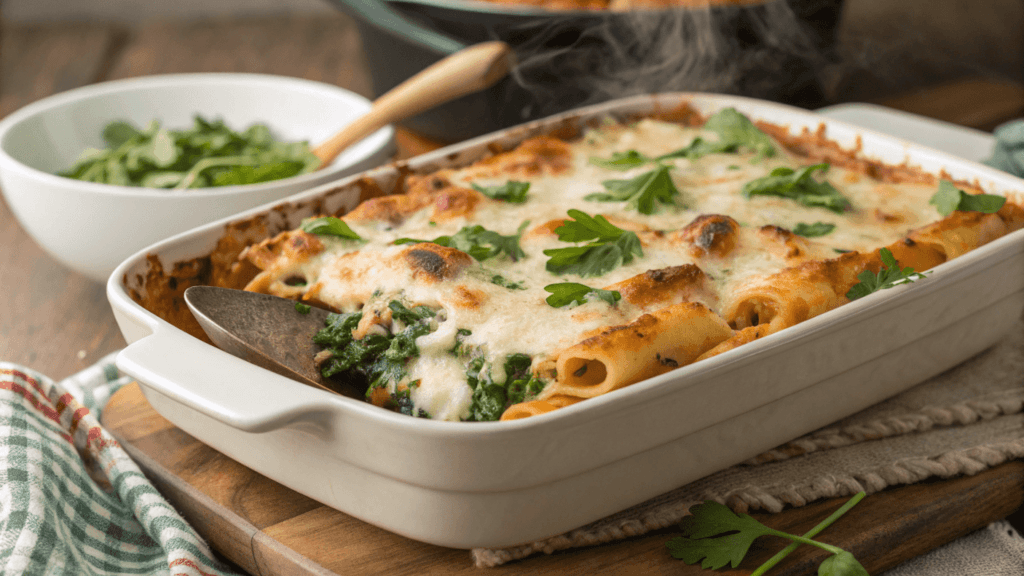
Now that we’ve uncovered all the delicious details about ziti pasta, it’s time to bring it to life with a cozy classic—Baked Ziti with Spinach and Ricotta. Let’s get cooking!
Ingredients
Let’s gather everything you need to create this hearty and delicious Baked Ziti with Spinach and Ricotta. Each ingredient has a purpose, and together, they make magic!
- Ziti Pasta – 16 oz (1 lb): The star of the dish! Its smooth surface and hollow center hold the sauce perfectly.
- Fresh Spinach – 3 cups, chopped: Adds a burst of green and balances the richness of the cheese. Plus, it’s packed with nutrients!
- Ricotta Cheese – 1 cup: This creamy delight makes the dish luscious and adds a hint of tanginess.
- Mozzarella Cheese – 2 cups, shredded: Melts into gooey perfection, giving each bite a cheesy pull.
- Parmesan Cheese – 1/2 cup, grated: A salty and nutty finishing touch that ties everything together.
- Marinara Sauce – 3 cups: Brings a rich, tomatoey base to the dish, infusing every layer with flavor.
- Garlic – 3 cloves, minced: Adds a savory kick and elevates the sauce.
- Olive Oil – 2 tablespoons: For sautéing garlic and ensuring a velvety sauce.
- Italian Seasoning – 2 teaspoons: A blend of herbs that gives the dish a signature Italian flavor.
- Salt and Black Pepper – To taste: Enhances all the flavors and adds a touch of spice.
Now that you have your ingredients, let’s jump into the fun part—cooking!
Step-by-Step Instructions
Step 1: Cook the Pasta
- First, boil a large pot of salted water. Add the ziti and cook until al dente, about 10 minutes.
- Drain the pasta but don’t rinse. The starch helps the sauce stick beautifully.
Step 2: Prepare the Spinach
- Heat olive oil in a skillet over medium heat.
- Add minced garlic and sauté until fragrant. Then, toss in the chopped spinach.
- Cook until the spinach wilts, about 2 minutes. Remove from heat.
Step 3: Mix the Cheeses
- In a mixing bowl, combine ricotta, 1 cup of mozzarella, and Parmesan cheese.
- Add the cooked spinach and mix well. Season with a pinch of salt and black pepper.
Step 4: Assemble the Ziti
- Preheat your oven to 375°F (190°C).
- In a greased baking dish, spread a thin layer of marinara sauce.
- Add half of the cooked ziti, followed by half of the cheese-spinach mixture.
- Repeat the layers, ending with marinara sauce on top. Sprinkle the remaining mozzarella over the dish.
Step 5: Bake to Perfection
- Cover with foil and bake for 20 minutes.
- Remove the foil and bake for an additional 10 minutes, until the cheese is golden and bubbly.
Serving
This recipe serves 6 hearty portions, perfect for a family dinner or a small gathering.
- Serve it piping hot as a main dish. Add a side of garlic bread or a fresh Caesar salad for a complete meal.
- Garnish with chopped basil or extra Parmesan for added flavor and flair.
- For a fun twist, try serving leftovers as a filling for wraps or sandwiches.
Tips and Hacks
- Tip 1: For a lighter version, use part-skim ricotta and mozzarella.
- Tip 2: Add extra vegetables like mushrooms or zucchini for more texture.
- Tip 3: Swap marinara for a creamy Alfredo sauce for a rich variation.
- Tip 4: Store leftovers in an airtight container in the fridge for up to 3 days. Reheat in the oven or microwave.
Nutrition Facts
Serving size: 1 portion
Calories: 420
Fat: 15g
Carbs: 52g
Protein: 18g
Sodium: 600mg
Fiber: 4g
Note: Nutrition values are estimates and may vary based on ingredient brands or portion sizes.
Prep Time
Prep time: 15 minutes
Cook time: 30 minutes
Total time: 45 minutes
Note: Times are approximate and depend on your cooking pace.
Enjoy your cozy and delicious Baked Ziti with Spinach and Ricotta! 😊
Frequently Asked Questions (FAQs)
What pasta is closest to ziti?
The closest pasta to ziti is penne. Penne shares a similar tubular shape but has diagonal cuts and ridges. Next is rigatoni, which is slightly wider and ridged for holding heavier sauces. Bucatini, although hollow like ziti, is thinner and works great in soups. These pastas make excellent substitutes, providing similar textures for your favorite dishes!
What is a good substitute for ziti pasta?
A good substitute for ziti pasta is penne, thanks to its similar size and versatility. Rigatoni is another great choice, especially for baked dishes. If you’re making soups, bucatini’s hollow center captures broths perfectly. Choose a pasta that fits your recipe’s needs and sauce type. You’ll love experimenting with these alternatives to recreate classic ziti recipes!
What do Italians call ziti?
In Italy, ziti is sometimes called “zite” in southern regions, like Naples. This name refers to its traditional use at weddings, symbolizing celebration and joy. Italians also use the term “maccheroni” as a general name for tubular pastas, including ziti. Whether called ziti or zite, it’s loved for its simplicity and versatility in Italian cooking!
Are penne and ziti the same thing?
Penne and ziti look similar, but they’re not exactly the same. Penne has diagonal ends and ridges, making it great for gripping sauces. Ziti, on the other hand, is smooth with straight edges, giving it a different texture. Both are perfect for various recipes, but their slight differences can influence how they pair with sauces. Try both to see which you prefer!
Conclusion: Embracing the Many Names and Uses of Ziti Pasta
Ziti pasta isn’t just a delicious ingredient; it’s also a symbol of versatility and tradition. You may wonder, “What is another name for ziti pasta?” In Italian regions, names like zite or maccheroni highlight its cultural significance. Around the world, variations exist, but ziti remains a favorite for its smooth texture and ability to hold sauces perfectly.
Whether baked in casseroles, tossed in salads, or added to soups, ziti shines in every dish. Next time you’re cooking, consider experimenting with similar pastas like penne or rigatoni for a fun twist. Each shape brings its own charm and enhances your recipe in unique ways.
Cooking with ziti or its alternatives is not just about following recipes; it’s about enjoying the process. So, gather your ingredients, explore the possibilities, and let the magic of ziti inspire your next meal!

